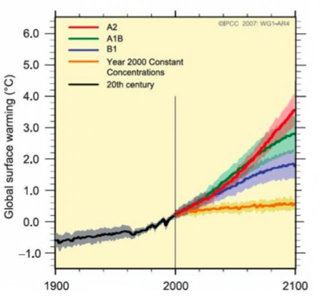
What will the future look like?
This module will help students to understand:
-
What areas of your country experience the highest rate of precipitation
-
How the rate of precipitation is expected to change in the next 50 years
How do we think extreme events will change?
They will vary from region to region. For example more flooding is expected in the Asian monsoon region and other tropical areas, future tropical cyclones could become more severe and there will be an increased risk of more intense, more frequent and longer-lasting heat waves in Europe.
Heat waves
The European heat wave of 2003 is an example of the type of extreme heat event lasting from several days to over a week that is likely to become more common in a warmer future climate. In pre-industrial times, the 2003 heat wave would have been a 1 in 1000 event. By the 2040s the average summer is predicted to be like the one we experienced in 2003; this in turn would be viewed as being relatively cold compared to the average summer temperature predicted for the 2060s.
Frost
It is also likely that a warmer future climate would have fewer frost days (i.e., nights where the temperature dips below freezing) and so the growing season is expected to get longer.
Rainfall and flooding
In a warmer future climate, most climate models project decreased summer rainfall and increased winter rainfall in most parts of the northern middle and high latitudes. Along with the risk of summer drought, there is an increased chance of episodes of intense rainfall and flooding. More flooding is also expected in the Asian monsoon region and other tropical areas and in a number of major river basins.
Cyclones
There is evidence from modelling studies that future tropi cal cyclones could become more severe, with greater wind speeds and more intense rainfall, although the actual number of cyclones may not change.
What about other aspects of climate, like rainfall, ice cover and sea level?
Many aspects of climate will change, not just temperature. Sea level is predicted to rise as the oceans get warmer and as some ice on land melts.
Rainfall
Most climate models predict that globally averaged rainfall will increase over time, with the biggest increases closes to the poles and in the Indian monsoon, and the smallest changes in subtropical regions.
Sea level
The two major causes of global sea level rise are water expanding as it warms and loss of land-based ice due to increased melting. Currently thermal expansion of the oceans is the main contributor to rising sea levels. The increasing melting of land-based ice is unlikely to have a significant effect on sea levels until 2100.
Note that, although sea ice (ice floating on the sea) has already started melting, and is predicted to melt more rapidly in the future, this does not affect sea level, as it is already floating and displacing its own weight in water.
Ice sheets
The two major ice sheets are the Greenland ice sheet and the Antarctic ice sheet.
The Greenland ice sheet contains enough water to contribute about 7 m to sea level. A sustained rise in local temperatures of about 3 °C (that’s global warming of about 1.5 °C) is likely to be reached by the end of the century if human-made emissions are not controlled. This would melt the Greenland ice sheet, although it would not happen immediately and it is estimated that this would take a few thousand years.
The West Antarctic ice sheet is the part of the Antarctic ice sheet most vulnerable to climate change. It contains enough water to contribute about 6m to sea level.
What are "tipping points"?
Tipping points refer to abrupt climate change. An example of abrupt climate change would be the rapid loss of the Greenland ice sheet. However, abrupt changes like this are not likely to occur in the 21st century.
The potential for climate to change relatively rapidly does exist. Abrupt climate change has occurred naturally in the past. A gigantic release of methane from below the ocean bed 56 million years ago led to a sudden warming of 6°C in the climate at a time when global temperatures were much higher than now. During the last ice age, collapses in the ice sheet over North America led to the Gulf Stream switching direction and the temperature across the North Atlantic dropping some 10°C within decades.
An important concern is that the continued growth of greenhouse gas concentrations in the atmosphere may trigger abrupt changes, which become more likely as the concentration of greenhouse gases in the atmosphere increases.
However, abrupt changes such as the collapse of the West Ant arctic ice sheet, the rapid loss of the Greenland ice sheet or large-scale changes of ocean circulation systems, are not considered likely to occur in the 21st century. As the total melting of the Greenland ice sheet, which would raise global sea level by about seven metres, is a slow process, it would take many hundreds of years to complete.
What do we think will happen to the temperature of the Earth?
Global temperatures are likely to rise 2-4°C by the end of the 21stcentury. The actual temperature rise depends partly on how much greenhouse gas is emitted over the next 90 years.
The Intergovernmental Panel on Climate Change (IPCC) “best estimate” of global warming is 2-4°C by the end of the century. This may not seem like much but it is an average; it conceals a greater warming in some seasons and some areas (particularly at higher latitudes) and less in others, for example nearer the Equator.
In order to make projections about future climate change, scenarios that describe possible global emissions of greenhouse gases are used. These scenarios are based on different ‘storylines’ that illustrate how things may change in the future. They take into account different projected trends in population, economic and technological developments, as well as changes in the political environment.
Future carbon scenarios

Future carbon scenarios- Intergovernmental Panel on Climate Change (2007) IPCC Fourth Assessment Report. Climate Change. [Accessed June 2009]
Three scenarios are shown in the graphic above as follows:
-
A high carbon world, medium-high emissions scenario (A2). This is based on a fairly divided world, where nations are self reliant and operate independently. Population rises continually, economic development is mainly regional and technological change is slow and fragmented.
-
A medium carbon world, medium-low emissions scenario (A1B). This is based on a more integrated world. There is rapid economic growth on a global scale, technological change is fast and efficient, and there is a balanced emphasis on all energy sources. Global population rises to 9 billion in 2050 then declines.
-
A low carbon world, low emissions scenario (B1). This is based on a more integrated and ecologically friendly world. There is rapid economic growth as in A1 but with rapid changes towards a service and information economy. Global population rises to 9 billion in 2050 then declines. Introduction of clean and resource efficient technologies, and an emphasis on global solutions to economic, social and environmental stability.
File nameFiles
File type
Size
Download

